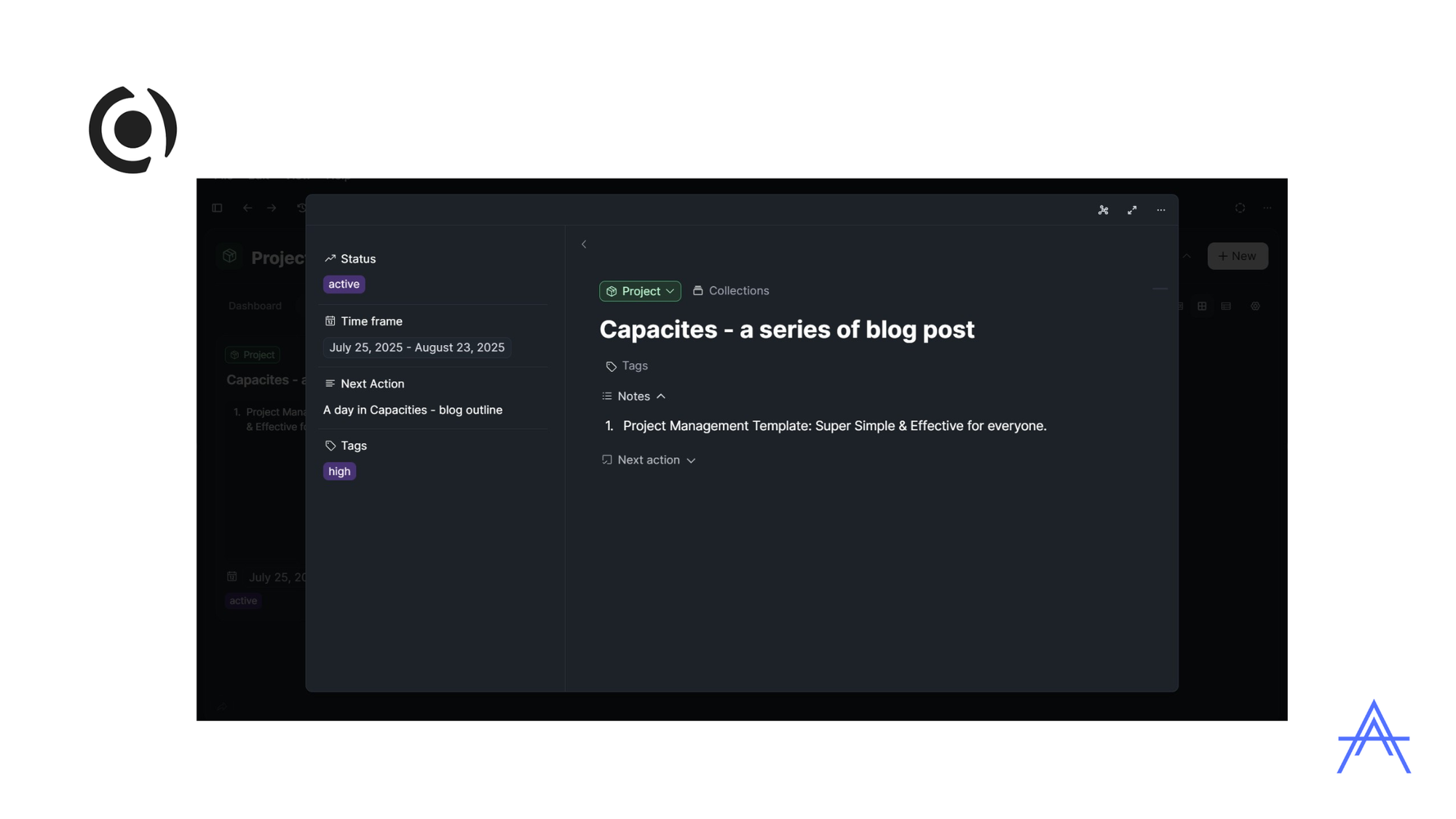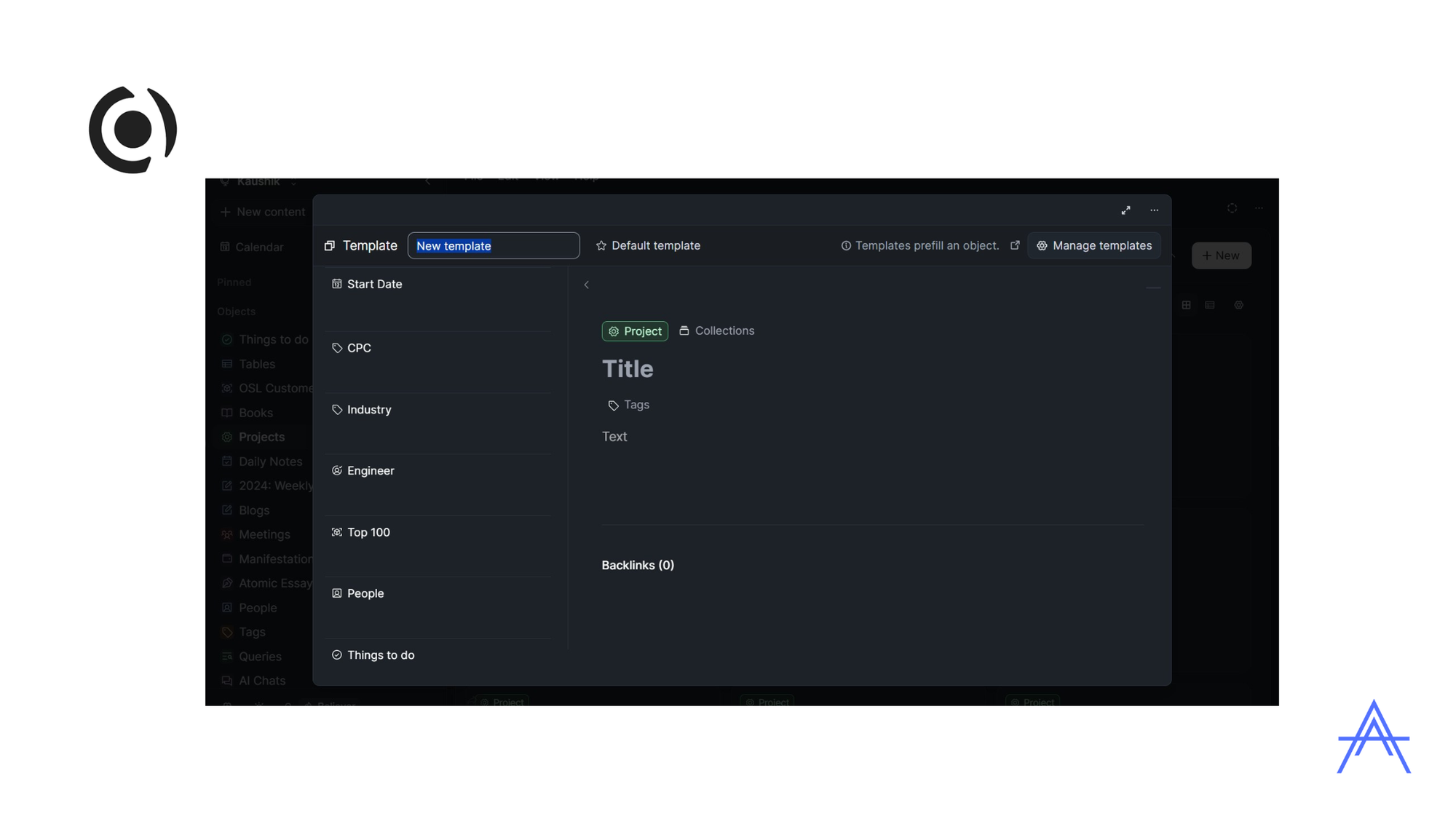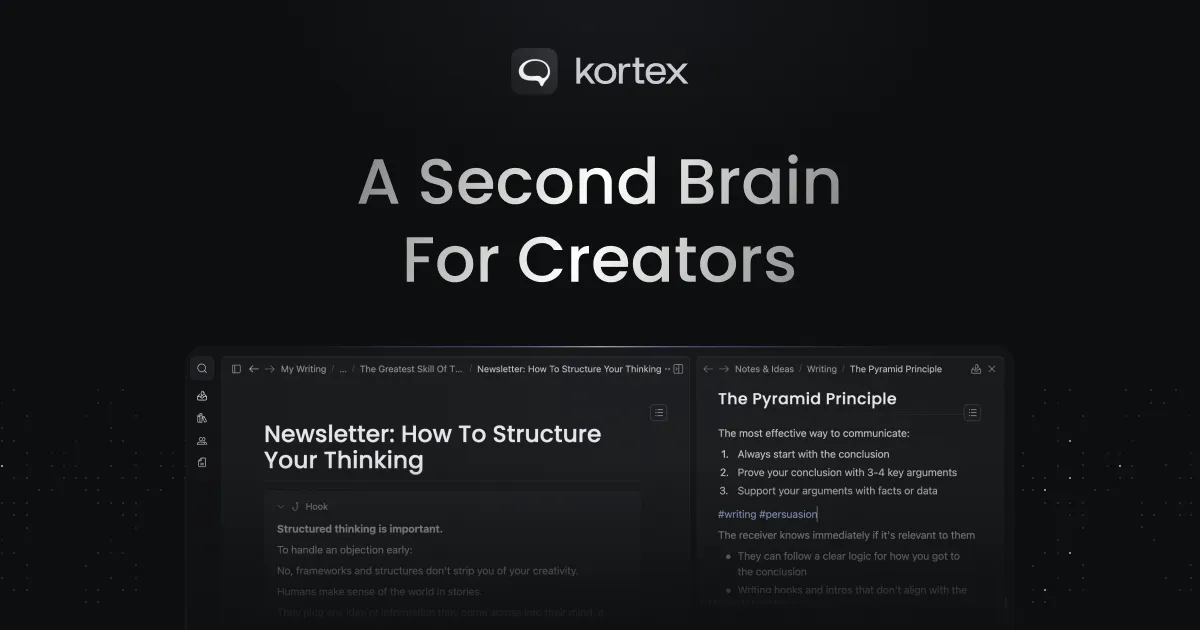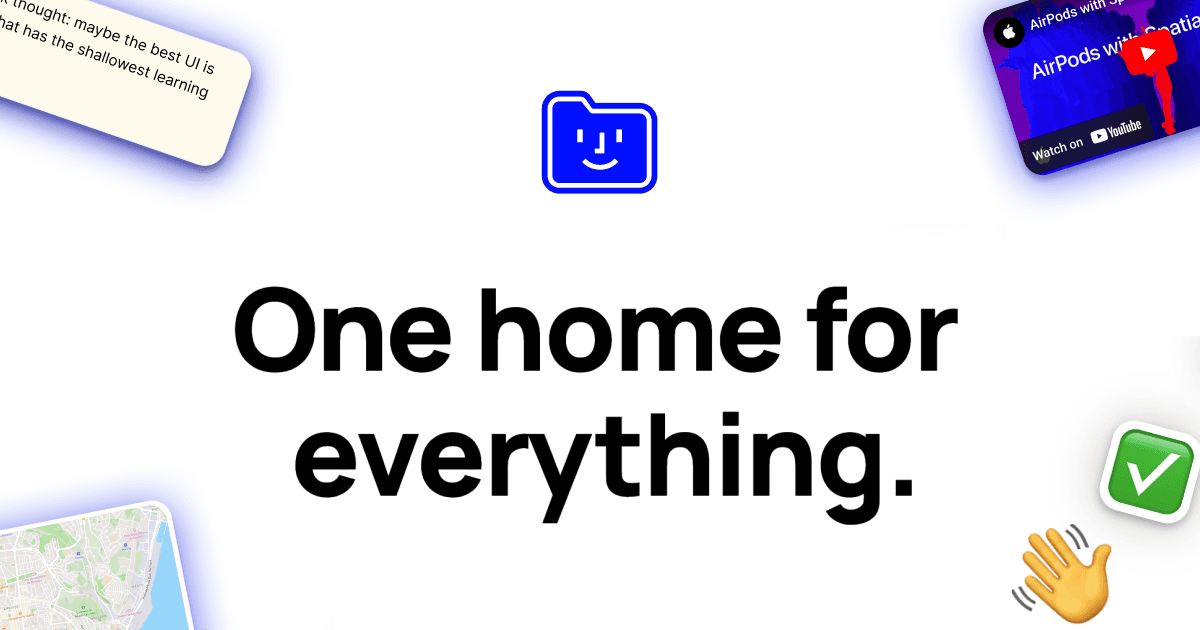Project management doesn’t have to be complicated. In fact, the best project management systems are often the simplest ones—those that get out of your way and let you focus on what actually matters: getting things done.
After trying countless project management tools over the years (Notion, Coda, Tana (Plan to use till my sub last (Feb' 25), Amplenote, Superlist, Todoist, Reflect & many) I’ve found that Capacities offers something unique: the perfect balance between simplicity and power. It’s not just another task manager or note-taking app—it’s a flexible workspace that adapts to how you think and work.
Today, I’ll show you how to create a project management template in Capacities that’s both simple enough for daily use and robust enough to handle complex projects. Best of all? You’ll have a system that grows with you.
This is just a first blog post on the series that I am planning to write. The idea is to share my use case of project, knowledge, information, everyday productivity, tasks related apps.
I am starting this series with 'Capacities'.
Why Simple Project Management Wins
Before diving into the how-to, let’s address the elephant in the room:
why do most project management systems fail?
The answer is usually overcomplication.
We start with grand visions of color-coded Gantt charts, complex dependency tracking, and elaborate reporting dashboards.
Then reality hits—we spend more time managing the system than actually working on our projects.
The best project management system is the one you actually use.
That’s where Capacities shines. Its object-based approach means you can start simple and add complexity only when needed. You’re not forced into rigid templates or overwhelming features you’ll never use.
Why I Chose Capacities for Project Management
Let me be honest—I’ve tried them all. Notion, Coda, ClickUp, Tana, Amplenote, Reflect. Each has its strengths, but they all share common problems:
- Complex setup processes that take days to configure
- Steep learning curves that slow down your team
- Platform limitations that lock you into specific workflows
Capacities tackles these issues head-on:
1. Value for Money
At just $10/month for the personal plan, Capacities delivers enterprise-level functionality at a fraction of the cost. Compare that to Notion ($8-16/user/month) or ClickUp ($7-19/user/month), Superlist ($21 with Ai meeting notes), Tana (Pro $14/month) and the value becomes clear.
This is specifically beneficial with Capacities, if I considered the price parity and payment in my local currency, INR. (India)
2. Cross-Platform Excellence
Whether you’re on Mac, Windows, iOS, or Android, Capacities provides a consistent, native experience. No more switching between clunky web interfaces and mobile apps that feel like afterthoughts.
3. Gentle Learning Curve
Unlike tools that overwhelm you with options, Capacities introduces concepts gradually. You can start with basic note-taking and evolve into complex project management naturally.
The Capacities Philosophy: Objects, Networks, and Time
Before building our template, it’s important to understand Capacities’ core philosophy. The platform is built on three pillars:
- Objects - Everything is an object with properties (projects, tasks, notes, people)
- Networks - Objects connect to create meaningful relationships
- Time - Everything exists in temporal context with smart calendar integration
This foundation makes project management feel natural rather than forced.
Building Your Project Management Template
Step 1: Define Your Project Essentials
Start by asking yourself: “What do I actually need to track for my projects?”
Don’t overthink this. Focus on information you’ll reference regularly:
- Project title and description
- Current status (planning, Active, On Hold, Complete)
- Key dates (start date, deadline)
- Priority level - I use (potential class - 0, 1, 2)
- Related resources (notes, files, team members)
- Progress tracking (tasks, milestones)
Pro tip: Start with fewer fields, not more. You can always add complexity later.
Step 2: Create Your Project Object Type
In Capacities, everything starts with creating an Object Type—think of it as a template for similar items.
To create your Project type:
- Navigate to Object Types in your workspace
- Click “Add New Object Type”
- Name it
Projectand choose an appropriate icon (I use 📋) - Add a brief description: “Template for tracking project progress and resources” - if you want to use one.
Step 3: Configure Essential Properties
Now for the core of your template. Here are the properties I recommend:
Property Name | Type | Options/Notes |
|---|---|---|
Description | Text (Long) | Project overview and goals |
Status | Select | Planning, Active, On Hold, Complete |
Start Date | Date | When work begins |
Target Date | Date | Planned completion |
Priority | Select | High, Medium, Low |
Project Type | Tags | Work, Personal, Learning, etc. |
Team Members | Relation | Link to Person objects |
Resources | Relation | Link to Note/File objects |
Tasks | Relation | Link to Task objects (Next Action) |
Step 4: Create Supporting Object Types
For a complete system, you’ll want these additional types:
Task Object Type:
- Title (Text)
- Status (Select: Todo, In Progress, Done)
- Due Date (Date)
- Assigned To (Relation to Person)
- Project (Relation to Project)
Person Object Type:
- Name (Text)
- Role (Text)
- Email (Text)
- Current Projects (Relation to Project)
Step 5: Build Your Master Template
Create your first project as a template:
Title: "Project Template"
Description: "Use this as a starting point for new projects"
Status: Planning
Priority: Medium
Project Type: Template
When starting a new project, duplicate this template and customize it.
Visualizing Your Projects
One of Capacities’ strengths is its flexible views. Here are three essential project views:
1. Active Projects Dashboard
Create a filtered view showing only projects with status “Active” or “Planning”. Pin this to your workspace for daily reference.
I am loving the queries and creating a dedicated views with it.
2. Timeline View
Use the calendar integration to see project deadlines and milestones in temporal context.
3. Team View
Group projects by team members to see workload distribution.
Real-World Example: My Current Setup
Here’s how I’m currently tracking a real project for my side-hustle (I am not sure to share my 9-5 project here🙃)
Project: “Capacities Blog Series”
- Status: Active
- Target Date: End of this month
- Priority: High
- Team Members: Just me (for now)
- Tasks:
- ✅ Draft project management template post
- 🔄 Create supporting screenshots
- ⏳ Write day-in-Capacities post - outline
- ⏳ Plan task management tutorial - outline
This simple structure gives me everything I need without overwhelming complexity.


Tips for Long-Term Success
Start Small, Think Big
Begin with basic project tracking. As you get comfortable, add properties like budget tracking, client communications, or detailed milestone planning.
Don't try to create a perfect project management set-up on a day one, practice and improvise.
Embrace the Network Effect
The magic happens when objects connect. Link related projects, reference similar past work, and build a knowledge network that gets smarter over time.
Connect Project-Task-Meeting-Daily notes and see the magic.
Use Templates Consistently
Create project templates for different types of work (client projects, personal goals, learning initiatives). Consistency reduces mental overhead.
I am not a big time Template player, but you can create a few to test.
Review and Refine
After completing a few projects, review your template. What fields did you ignore? What information did you need but didn’t capture? Iterate accordingly.
The key to success is 'Review' - your daily notes, ideas, task and projects.
Why This Approach Works
This isn’t just another productivity hack—it’s a sustainable approach to project management because:
- Low cognitive overhead: Simple structure means less thinking about the system
- Flexible scaling: Add complexity only when projects demand it
- Cross-platform consistency: Your system works the same everywhere
- Value-driven pricing: Professional capabilities without enterprise costs
- Future-proof: Object-based structure adapts as your needs evolve
What’s Next?
This project management template is just the beginning. In upcoming posts, I’ll dive deeper into:
- A day in Capacities: How I use calendar integration and daily workflows
- Capacities and my task management: Breaking down complex projects into actionable steps
- Capacities as a PKM tool: Building a second brain for project knowledge
The goal isn’t to create the most complex system possible—it’s to build something that genuinely makes your work easier and more enjoyable.
Ready to simplify your project management? Start with this template in Capacities and discover how powerful simplicity can be.
❤️ Enjoy the blog?
Forward this issue to a friend and ask them to subscribe
Just wanna say hello? Hit reply and introduce yourself!
If you want to support app advocate, there is no subscription fees you can support do by buying me a Coffee.
Your support is very appreciated!
Thank you for reading!
Stay Productive,
Astu.
You can extend your support to an independent blogger and app reviewer by using any of the following affiliate productivity apps (truly tested and best in class) at no extra cost:








